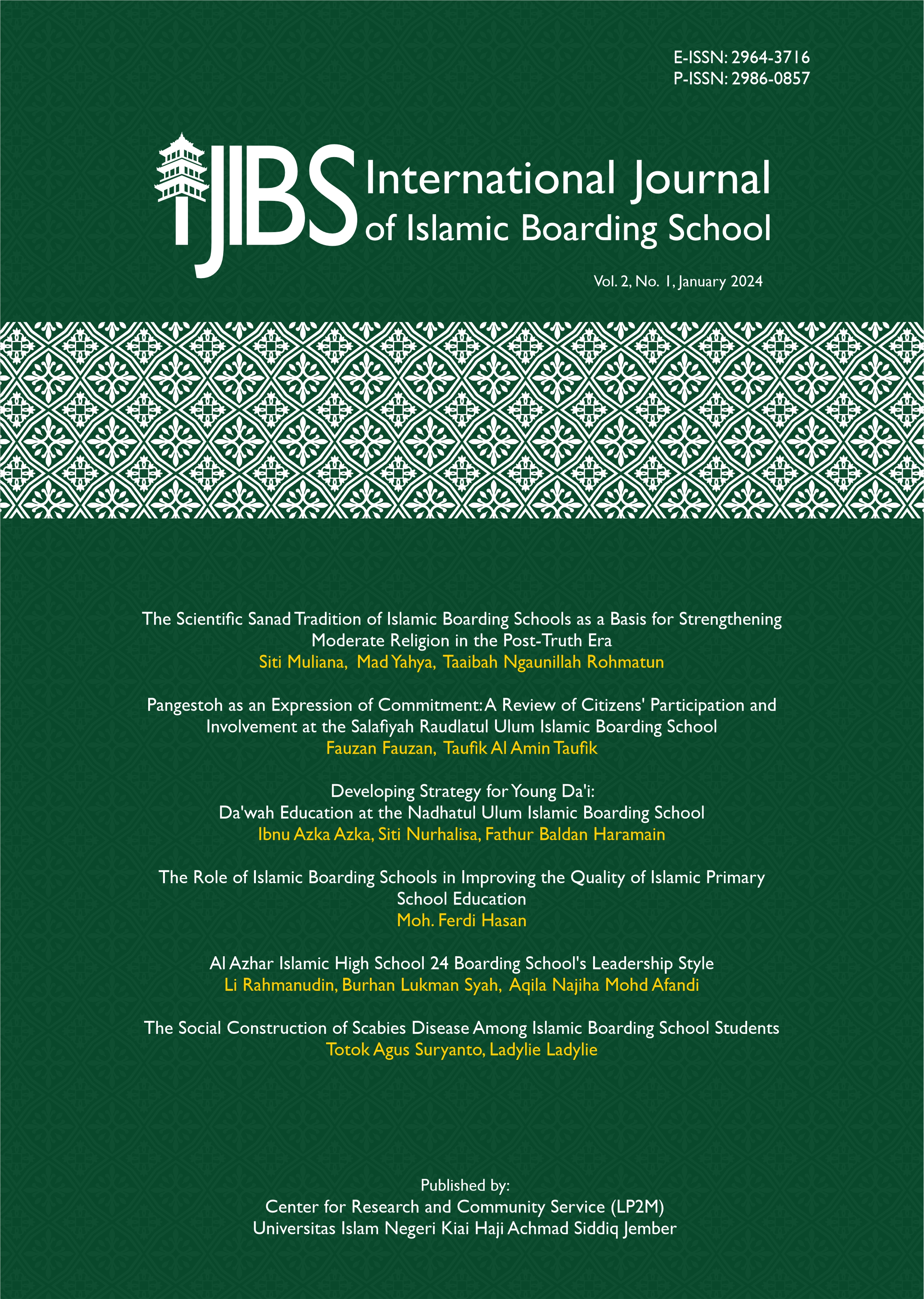The Social Construction of Scabies Disease Among Islamic Boarding School Students
DOI:
https://doi.org/10.35719/ijibs.v2i1.42The social construction of scabies among Islamic boarding school students (santri) is a critical yet underexplored issue. Previous studies have not fully addressed how scabies is perceived and constructed within this community. This study focuses on understanding the meanings and social interactions surrounding scabies among santri. Using a qualitative exploratory descriptive approach, data were collected through participant observations, in-depth interviews, and documentation studies. Analysis involved data interpretation, display, and conclusion withdrawal, guided by Berger and Luckmann's theory of social construction, which includes externalization, objectivation, and internalization. The findings reveal diverse meanings attached to scabies among santri, including "santri stamp," "legitimate," "grace and favors," "blessing entrance," "routine disease," and "the value of togetherness." These meanings stem from social prestige and collective subjectivity shaped by the roles and statuses within the boarding school environment. The social construction of scabies among santri is maintained through the ongoing willingness of social agents to adhere to daily activities that reinforce existing social constructions. This study highlights the importance of understanding health conditions' social meanings within specific cultural contexts, significantly impacting community responses and management strategies.
References
Arisandi, H. (2015). Buku Pintar Pemikiran Tokoh-Tokoh Sosiologi: Dari Klasik Sampai Modern. IRCiSOD.
Aulia, R. N., Isnaini, D. E. N., & Khumairoh, U. (2017). Pengelolaan Lingkungan Berbasis Pesantren (Studi Kasus di Pondok Pesantren Nurul Hakim Lombok). Hayula: Indonesian Journal of Multidisciplinary Islamic Studies, 1(2), 119. https://doi.org/10.21009/hayula.001.2.06
Berger, P. L. (1994). Langit Suci; Agama Sebagai Realitas Sosial. LP3ES.
Berger, P. L. & Luckmann, T. (2013). Tafsir Sosial Atas Kenyataan: Risalah Tentang Sosiologi Pengetahuan. LP3ES.
Bungin, Burhan. (2014). Metodologi Penelitian Kuantitatif: Komunikasi, Ekonomi, dan Kebijakan Publik serta Ilmu-Ilmu Sosial Lainnya. Kencana.
F. Murad. (2022, Desember). Wawancara Tentang Penyakit Scabies di Kalangan Santri Pondok Pesantren [Personal communication].
Fitri Muta’afi dan Pambudi Handoyo. (n.d.). Konstruksi Sosial Masyarakat Terhadap Penderita Kusta. PARADIGMA, 03, 1–7.
Foster, George & Anderson, Barbara. (1986). Antropologi Kesehatan. UI-Press.
Ifan Sugianto. (2022, November 27). Wawancara Tentang Penyakit Scabies di Kalangan Santri Pondok Pesantren [Personal communication].
Kanani, N., Ernayati, W., Lufar, N., Kustiningsih, I., Wardhono, E. Y., Wardalia, W., Sari, L. N., Apriantika, A. P., & Yulvianthy, M. (2024). Penerapan Teknologi Tepat Guna untuk Menurunkan Kasus Penyakit Scabies Santri Pondok Pesantren An-Nur di Kecamatan Walantaka, Provinsi Banten. Wikrama Parahita : Jurnal Pengabdian Masyarakat, 8(1), 129–136. https://doi.org/10.30656/jpmwp.v8i1.7357
Kurniawan, E., Aini, A., & Rahmawati, S. (2019). Penyuluhan Penanganan Penyakit Scabies di Yayasan Pondok Pesantren Ma. Ishlahil Athfal Rumak Lombok Barat. Jurnal Pengabdian Magister Pendidikan IPA, 2(2). https://doi.org/10.29303/jpmpi.v2i1.320
M. Dodi. (n.d.). Wawancara Tentang Penyakit Scabies di Kalangan Santri Pondok Pesantren [Personal communication].
Moh. Ifan. (2022, November 11). Wawancara Tentang Penyakit Scabies di Kalangan Santri Pondok Pesantren [Personal communication].
Moh. Kholil Rais. (2022, November 26). Wawancara Tentang Penyakit Scabies di Kalangan Santri Pondok Pesantren [Personal communication].
Musni, R., Safuwan, S., Junita, N., Shintiasa, A. G., & Zuchra, C. M. D. (2022). Tatalaksana dan Pencegahan Penyebaran Penyakit Scabies pada Santri Dayah Terpadu Al-Muslimun Lhoksukon Aceh Utara. Gotong Royong : Jurnal Pengabdian, Pemberdayaan Dan Penyuluhan Kepada Masyarakat, 2(1), 22–26. https://doi.org/10.51849/jp3km.v2i1.23
Prastowo, Andi. (2014). Memahami Metode-Metode Penelitian. Ar-Ruzz Media.
Ritzer, George & Smart, Barry (Ed.). (2015). Handbook Teori Sosial. Nusa Media.
Shella Norma Windrasari. (n.d.). Konstruksi Sosial Obesitas Pada Perempuan Menikah. Perpustakaan Universitas Airlangga.
Sugiyono. (2014). Statistik Untuk Penelitian. Alfabeta.
Susilo, A. A., & Wulansari, R. (2020). Sejarah Pesantren Sebagai Lembaga Pendidikan Islam di Indonesia. Tamaddun: Jurnal Kebudayaan Dan Sastra Islam, 20(2), 83–96. https://doi.org/10.19109/tamaddun.v20i2.6676
Ulum, B. (2022, Oktober). Wawancara Tentang Penyakit Scabies di Kalangan Santri Pondok Pesantren [Personal communication].
Zainuddin. (2022, November 26). Wawancara Tentang Penyakit Scabies di Kalangan Santri Pondok Pesantren [Personal communication].
Zainurridho. (2022, Oktober). Wawancara Tentang Penyakit Scabies di Kalangan Santri Pondok Pesantren [Personal communication].
Zuaidi. (2022, Oktober). Wawancara Tentang Penyakit Scabies di Kalangan Santri Pondok Pesantren [Personal communication].
Downloads
Published
Issue
Section
License
Copyright (c) 2024 Totok Agus Suryanto, Ladylie

This work is licensed under a Creative Commons Attribution-NonCommercial 4.0 International License.
License
1. Author’s Warranties
The author warrants that the article is original, written by stated author/s, has not been published before, contains no unlawful statements, does not infringe the rights of others, is subject to copyright that is vested exclusively in the author and free of any third party rights, and that any necessary written permissions to quote from other sources have been obtained by the author(s).
2. Miscellaneous
IJIBS will publish the article (or have it published) in the journal if its editorial process is successfully completed and IJIBS or its sublicensee has become obligated to publish it. IJIBS may conform the article to a style of punctuation, spelling, capitalization, and usage that it deems appropriate.

















 IJIBS licensed under Creative Commons Attribution-NonCommercial 4.0 International License.
IJIBS licensed under Creative Commons Attribution-NonCommercial 4.0 International License.